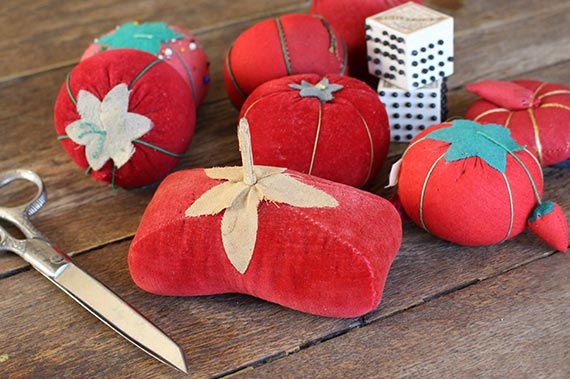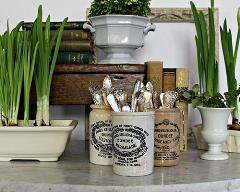


On Display
By Johi Kokjohn-Wagner
Photos courtesy Anne Theisen & Kim Bongiorno
Collections have many motivations: hobby, investment, knowledge, preservation, socialization or simply enjoyment. The hunt, the find and the purchase can each be thrilling. Displaying your treasures, whether through separation or integration, is a fundamental part of collecting, but it requires some planning and intention.
Anne Karp, an antique collector and owner of Splendid Junk Vintage, shares her firsthand experience on collecting and displaying your treasures, while working within the space and function of your home.
Anne started collecting at an early age for reasons of frugality, but she learned to love it and eventually made a business from her passion.
“I have memories as a child of going to garage sales and auctions, but I started going to estate sales and antique co-ops as an inexpensive way to furnish my apartment when I was single. My husband and I continued to visit antique shows and estate sales to furnish our home,” Anne said. “After a rewarding 15-year career, I had two boys of my own; when they got a little older, I found I needed something that was mine—something that was not about nurturing my kids or my marriage, but about nurturing my soul. I found that in the hunt at estate sales and auctions. The joke is that estate sales offer me a legal and less creepy way to feed my love of going through other people’s stuff.”
Anne passed her antiquing appetite on to her children, making it not only a family affair but also a social event with other collectors.
“My boys have collections and love going to flea markets, estate sales and auctions,” she said.
Gathering the goods is the first step, the next—and equally important—step is all about displaying your fabulous finds.
Grouping collectables creates visual impact and adds drama or whimsy to your home, as well as providing an opportunity to edit. Display the most visually appealing items—ones that elicit the strongest emotional response. Grouping smaller items together ensures they are seen and appreciated.
 “Collections don’t have to be expensive or terribly valuable to spark joy or add character in a home. I have collections of mismatched antique silverware and red tomato pin cushions—none cost me more than $2,” Anne said. “One spoon or one old pin cushion on its own isn’t special, but together you see the variations in color, design, texture and now you have something visually interesting.”
“Collections don’t have to be expensive or terribly valuable to spark joy or add character in a home. I have collections of mismatched antique silverware and red tomato pin cushions—none cost me more than $2,” Anne said. “One spoon or one old pin cushion on its own isn’t special, but together you see the variations in color, design, texture and now you have something visually interesting.”
Anne cautions against getting too traditional with certain types of collectables, particularly inherited items. Use creativity in designing a display to personalize the space to your individual taste.
“We might love things our parents or grandparents owned but don’t want our homes to look dated,” she said. “Figuring out how to incorporate antiques and vintage pieces in a fresh, more modern way is a matter of playing around and displaying them in new and unexpected ways. Tea cups placed in a traditional china cabinet will feel dated, but that same gold-rimmed cup on a stack of vintage books on a clean, white shelf will bring out the gold embossing on the books and add curves to an otherwise linier display.”
A collection can easily be unified through use of repeated color, as in an art or photo wall using white frames. Textural contrast can also highlight a grouped display, such as a backdrop of rough, reclaimed barn wood behind a shiny, fine china collection.
 Separate & Assimilate
Separate & AssimilateAnother option for displaying is to disperse the collectables throughout your home. Separating and scattering like items can create an informal, integrated and accessible feel. Separation works best with larger items, such as furniture.
Anne encourages imagination when placing large pieces.
“Think beyond what it might have originally been used for, and try it in different spaces,” she said. “An old pie cupboard can look amazing in a bathroom housing linens and such.
“Heirlooms can add character, texture and warmth to a newer home, and I encourage people to try to get the story behind the objects they keep.”
Not everyone makes a business from selling their collections, yet Anne’s pieces are always in flux, depending on changing needs and desires. Rotating displays keeps your home feeling fresh and also provides an opportunity to deep-clean and reassess.
“Collections are constantly changing and evolving in my home with the seasons,” Anne said. “Not many homes 20 miles outside of New York City come with a barn, so I incorporate my style with that of my family, how we live and what makes us all feel comfortable in our home. We mix styles to balance formality and comfort.”
 Anne’s Internet shop is currently without a brick-and-mortar location, which requires her to get creative in her own home with merchandise storage. Sometimes, her finds are even added to her personal collection. Anne relies on her emotional reaction to a piece when deciding whether it stays or is released for sale.
Anne’s Internet shop is currently without a brick-and-mortar location, which requires her to get creative in her own home with merchandise storage. Sometimes, her finds are even added to her personal collection. Anne relies on her emotional reaction to a piece when deciding whether it stays or is released for sale.
“With limited storage, I often decorate with my finds until they sell,” Anne said. “The pieces we feel sick about letting go stick around longer, and that’s how my own collections get started. A Wonder Bread crate was listed on Etsy, and when I had a nibble I called my husband in a panic and we couldn’t let it go. The listing came down, and the crate is now a permanent part of our decor.”
“Decorating and interior design are not something that come naturally to me, as it does to some,” Anne admits.
Anne’s ideas for inspired design come from other sources, before being personalized to each space she decorates. Her designs have not always come easily or without fail, but Anne’s passion for collecting and love of home have fashioned a creative process she enjoys.
“I sit in book stores and read piles of magazine and decor books. I pour over Pinterest and decorating blogs; as with anything, you learn what you like and what you don’t like,” Anne said. “I go through lots of experimenting in design before I get to something that works, and I’ve learned to pay attention to the emotions I feel and how I want others to feel in my home. Does it feel calm, warm and welcoming? Does it feel too formal or too chaotic? Sometimes I nail it, and sometimes it’s a process. Just when I think I’m done, I find something else to ‘store.’ ”
Design DIY
Read more from Johi’s design series:
Elements With Intention
In Touch With Texture
Define, Design, Decorate
A New Shade
Punch It Up With Pattern
(Re)Design & Define
SHARE THIS